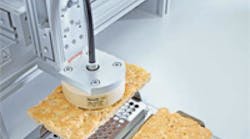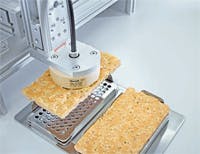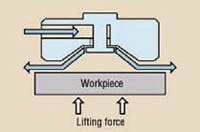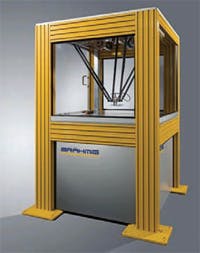Products with porous, permeable, rough, or soft surfaces are notoriously hard to handle. Grippers can leave pressure marks on sensitive parts such as circuit boards or CDs. Vacuum handling systems tend to pick up more dirt than product on workpieces with soiled surfaces. And both types can damage or even destroy particularly delicate objects.
Careful handling is paramount for sensitive goods such as cookies, plastics, paper, and electronic parts. At the same time, ever-increasing demands for higher productivity mean such products are not immune to efforts to increase cycle times and throughput levels. For applications that rule out the use of grippers or vacuum technology, the NCT noncontact transport system from Bosch Rexroth is a viable option for these difficult handling tasks.
Bernoulli principle
The NCT noncontact transfer units are disk-shaped components that lift objects without touching them with what may appear to be magic. But operation is actually based on the Bernoulli principle. This physical law states that pressure in a flowing fluid decreases as flow rate increases. The total energy of a steady flow remains constant for the entire flow path. This means that an increase in flow speed is always accompanied by a decrease in pressure.
In aeronautics, the Bernoulli principle defines the lift of an aircraft’s wing or other load-bearing surface based on higher air flow above the wing than below it. This creates higher pressure on the underside of the wing, thereby creating lift.
Airflow generates liftBosch Rexroth engineers take advantage of this principle in the NCT, generating a pressure differential to permit non-contact handling of delicate parts. Air flow below the NCT produces a vacuum in the center and around the circumference of the device that provides the lifting force between the transport unit and object. The continuous air flow and dynamic vacuum result in a small air pocket between the NCT and the object. Because there is no direct contact in this handling application, the workpiece appears to float. Unlike vacuum technology, the NCT does not leave marks on the workpiece or suction off contaminants – making this gentle handling technology especially suited for sensitive parts.
Various sizes (20, 30, 40, and 60 mm diameter) are available for different workpiece weights and sizes. They operate on nonlubricated compressed air at pressures ranging between 1 and 7 bar (15 to 102 psi), and the transport unit can lift objects weighing up to 1.0 kg (2.2 lb). Multiple NCTs can be grouped together in assemblies to increase lift capacity.
The NCT has been made of anodized aluminum and is now available in polyether ether ketone (PEEK). This semicrystalline, high-performance plastic features particularly strong chemical stability, making it useful, for instance, in medical applications as a material for artificial intervertebral discs and kneecaps. The PEEK non-contact lifting unit, designated NCT-PK, is therefore suitable for direct contact with foodstuffs, and its hygienic design complies with European Community (EC) and Food and Drug Administration (FDA) guidelines. The PEEK version enables both in-place cleaning and sterilization processes. And it is suitable for direct contact with silicon, indispensable in the semiconductor industry.
Kinematic robotics
The NCT is well suited for automated handling systems. For example Brhmig GmbH, Radeberg, Germany, has successfully used these components for several years. The custom-machine manufacturer relies on noncontact technology for difficult tasks such as handling wafers, charge air coolers, and felt shoe soles.
Brhmig’s latest undertaking will be to equip its Dynamotion parallel-kinematic robot with the NCT-PK. Working in concert with a vision system, the NCT picks up unsorted goods arriving on a belt, swivels them to the side, and places them precisely into their packaging.
According to Sandro Claus, Brhmig’s sales and marketing director, the NCT ensures, for instance, that the chocolate coating on pastry is not damaged by pressure points or scratches. In such applications, they eliminated vacuum as an alternative because traditional vacuum systems used in this environment ingest contaminants and require frequent filter maintenance, he explains.
The parallel kinematic robot uses three Rexroth MSK servomotors, connected via a crank arm and linking rods at a common operating point, to permit movements to any point in the working range. The robot is controlled by IndraMotion MLC motion logic system with integrated robotics.
Fast and precise handling
The Dynamotion accelerates at rates to 190 G and permits cycle times of 150 units per minute. However, cookies, and especially chocolate-coated pastries, require extremely gentle handling. Thus, precisely picking up and depositing 52 cookies per minute is considered very high throughput in the food industry. Quick-switching CD04 pneumatic directional valves control flow to the NCT, and an AS3 maintenance unit with activatedcarbon filters provides clean air to the NCT-PK, Claus explains.
The NCT-PK mounts at the end of the kinematic robot’s arms. Each cycle, air flow actuates the unit, and the product is lifted 10 cm, moved 50 cm horizontally, and placed back down 10 cm. Then the NCT switches off. The 40-mm NCT-PK gave the best results with test pastries, but Claus quickly points to simple conversion options: “Depending on the pastry or the individual application, we can select the size of the NCT so that its distribution of force is optimally suited to the product.”
In its latest system, Brhmig uses three or four consecutive kinematic robots. The Dynamotion increases production efficiency through short cycle times coupled with consistently high precision. In fact, in some applications, such as handling chocolate-coated cookies, the kinematic robot with NCTPK even automates some complex manual tasks for the first time. The system is suited for all types of flexible loading and repositioning processes for small parts in a wide range of industry sectors.
Click here for more information on the Bosch Rexroth Non-Contact Transport.
Click here to download a six-page PDF brochure.





